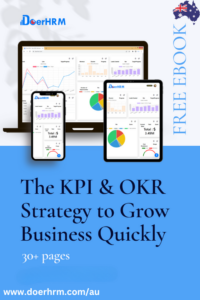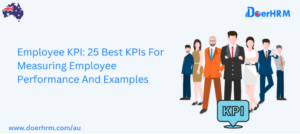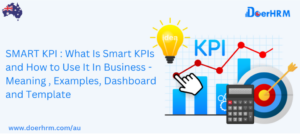Hi Managers, do your employees have signs of low motivation?
- Absenteeism or consistent late coming....
- Don’t-care attitude / no Initiative ...
- Constantly stressed/ bored....
- Conflict with peers/ boss....
- Leads negative discussions....
- Decrease in productivity and lousy quality of work....
Individual employee Key Performance Indicators (KPIs) are measurements that can help you track your employees’ ability to achieve your expectations and their effect on the company’s goals. However, do you know what these employee Key Performance Indicators are? Well, below we will be sharing the examples of employee Key Performance Indicators with you.
Top 18 Examples Of KPIs
- Absenteeism: The first employee Key Performance Indicator will be absenteeism. The absenteeism rate in the organization is usually calculated by dividing the number of working days in which the employee was absent by their total number of working days.
- Efficiency: While quality usually wins out over quantity, an employee’s overall efficiency is the strongest sign of their performance. That’s why efficiency is also one of the employee’s Key Performance Indicators. Efficiency is the amount of output you obtain for a given amount of effort, and it has a significant impact on overall business success.
- Attention to detail: The capacity to accomplish/complete a task while exhibiting a thorough concern for all of the aspects involved, no matter how minor, is known as the employee’s Key Performance Indicator, attention to detail. This entails keeping track of and double-checking work or information while effectively managing time and resources.
- Creativity and innovation: Employee connections are not based on formal hierarchical functions; rather, they are informal and centred on people. The feedback that emphasizes how an employee interacts with others in the organization rather than just as an individual fosters creativity and intrinsic motivation. Employees that are inherently excited and joyful about what they do are said to have intrinsic drive. It has an impact on job-related passion and interests. Employees that are motivated are more likely to take chances and come up with innovative ideas for products and services that provide them with a competitive advantage.
- Good time management: Good time management is an employee’s Key Performance Indicator as it can help you advance in your profession. Organizing your day allows you to finish work on schedule, stay focused during critical meetings, and be creative and proactive in your responsibilities. Having good time management skills can help you achieve important goals and advance in your career.
- Timeliness: Another employee Key Performance Indicator that should be tracked with caution is how quickly work is completed. The average customer’s downtime is a reliable predictor of timeliness in field service. It could be the number of units produced per hour in manufacturing.
- Creativity: It’s difficult to quantify creativity as an employee’s Key Performance Indicator, yet it’s critical in many white-collar positions. Supervisors and employees should keep note of and strive to quantify creative work instances.
- Personal Appearance: One of the employee’s Key Performance Indicators is personal appearance. While most employees know how to dress for work, at least one employee in every firm needs to be told. The impact of incorrect appearance and grooming on the employee’s performance and that of others should be explained, and corrective steps should be established.
- Consistency: Another employee Key Performance Indicator is consistency. Consistency at work entails adhering to the same set of norms and behaviours that result in high-quality work. Employees can increase their consistency by using time management techniques, setting production objectives, and finding areas where they can enhance their work ethic.
- Quality: There are various ways to assess the quality of work completed. One such measure is the percentage of work that needs to be redone or is rejected. The percentage of inquiries turned to sales in a sales environment is an indicator of salesmanship quality.
- Gossip and Other Personal Habits: While some personal habits, such as gossip, may not appear to be performance-related, they can detract from job performance and interfere with the performance of others. Specific habits should be outlined, and goals for reducing their frequency should be created. Thus, gossip and other personal habits will be taken as an employee’s Key Performance Indicator.
- Adherence to Policy: Policy adherence may appear to be the polar opposite of originality, yet it is only a limit on creativity. Deviations from policy suggest that an employee’s performance goals are not in sync with the company’s.
- Cost-Effectiveness: Only if the employee has some influence over costs should the cost of work accomplished be used as a measure of performance. A customer service representative’s performance, for example, is measured by the percentage of calls that must be escalated to more experienced and costlier representatives.
- Engagement: Engagement will be an employee Key Performance Indicator as employees that are engaged care about their work and the company’s performance, and they believe that their efforts matter. An engaged employee is motivated by more than a paycheck, and they may perceive their well-being to be tied to their performance, making them crucial to the company’s success.
- Teamwork: In most firms today, teamwork is an employee’s key performance indicator. It is critical to promote cooperation in the workplace, especially when employees must work in groups to solve complicated problems.
- Assessment Center: The employee is evaluated by professional assessors. One advantage of assessment centres is their objectivity, as they create reports that aren’t tainted by personal interactions with employees.
- Development and Training: Training focuses on quick improvements such as mastering a program upgrade, whereas development focuses on long-term goals. The quality of an employee’s performance is determined by the company’s training. Depending on the situation, companies have varying levels of training and employee performance objectives. This can boost your profit margin by as much as 24 per cent or more by making your staff better at their tasks. Training also aids in employee retention and turnover reduction. According to a recent poll, 68 per cent of employees believe that training and development is the most essential corporate policy therefore leaders must get to know their people and provide proper training to keep them. Hence, development and training are one of the employee’s Key Performance Indicators.
- Learning ability: Employees are judged on their ability to adapt and learn in order to stay current with industry developments. A few metrics that can be used to assess an employee’s learning abilities are listed below: Employees might be encouraged to participate in online training programs to assess their aptitude to learn.

Achieve Your Expectations By Measuring Your Employees KPIs
All in all, individual employee Key Performance Indicators are measurements that can help you track your employees’ ability to achieve your expectations and their effect on the company’s goals. Hope the employee Key Performance Indicators which are listed above can help you to understand better these employee Key Performance Indicators!
Click to see how DoerHRM’s KPI + Strategy Execution Software helps to build winning teams that know where they’re going, and how they’re doing it. Ultimately, helping the teams to stay on track and become results-focus.










I find the topic intriguing, and the article raises some critical questions about the future of technology. However, I’m curious about the potential ethical implications. Would love to see a follow-up article exploring that aspect further.
While the article covers essential points, I’d love to see more real-life examples or case studies to support the claims made. Overall, it’s an informative piece, but adding practical examples would make it even more compelling
An eye-opening article on bridging the skills gap. The HR team will play a pivotal role in upskilling the workforce.
This article is a helpful guide for conducting efficient employee onboarding. Well written
I found this piece to be a valuable resource for HR professionals. Thanks for sharing
Thanks for sharing. I read many of your blog posts, cool, your blog is very good.